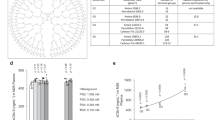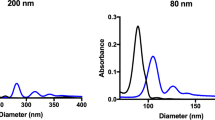Abstract
Deposition of complement factors (opsonization) on nanoparticles may promote clearance from the blood by macrophages and trigger proinflammatory responses, but the mechanisms regulating the efficiency of complement activation are poorly understood. We previously demonstrated that opsonization of superparamagnetic iron oxide (SPIO) nanoworms with the third complement protein (C3) was dependent on the biomolecule corona of the nanoparticles. Here we show that natural antibodies play a critical role in C3 opsonization of SPIO nanoworms and a range of clinically approved nanopharmaceuticals. The dependency of C3 opsonization on immunoglobulin binding is almost universal and is observed regardless of the complement activation pathway. Only a few surface-bound immunoglobulin molecules are needed to trigger complement activation and opsonization. Although the total amount of plasma proteins adsorbed on nanoparticles does not determine C3 deposition efficiency, the biomolecule corona per se enhances immunoglobulin binding to all nanoparticle types. We therefore show that natural antibodies represent a link between biomolecule corona and C3 opsonization, and may determine individual complement responses to nanomedicines.
This is a preview of subscription content, access via your institution
Access options
Access Nature and 54 other Nature Portfolio journals
Get Nature+, our best-value online-access subscription
$29.99 / 30 days
cancel any time
Subscribe to this journal
Receive 12 print issues and online access
$259.00 per year
only $21.58 per issue
Buy this article
- Purchase on Springer Link
- Instant access to full article PDF
Prices may be subject to local taxes which are calculated during checkout






Similar content being viewed by others
Data availability
The mass spectrometry proteomics data have been deposited to the ProteomeXchange Consortium via the PRIDE partner repository with the dataset identifier PXD011781. The raw data that support the graphs in Figs. 1c,d,e,g,h,i; 2c,d,e,f; 3c,d,e,f,i,j,k,l; and 5d are available in extended Supplementary Information. Any additional data and data analysis scripts for R are available from L.S. upon request.
Change history
22 January 2019
In the version of this Article originally published, a technical error led to Fig. 1a containing ‘!!!!!!!!’ above the scale bar. This has now been corrected in all versions of the Article.
References
D’Mello, S. R. et al. The evolving landscape of drug products containing nanomaterials in the United States. Nat. Nanotech. 12, 523–529 (2017).
Boraschi, D. et al. Nanoparticles and innate immunity: new perspectives on host defence. Semin. Immunol. 34, 33–51 (2017).
Monopoli, M. P. et al. Physical-chemical aspects of protein corona: relevance to in vitro and in vivo biological impacts of nanoparticles. J. Am. Chem. Soc. 133, 2525–2534 (2011).
Cedervall, T. et al. Understanding the nanoparticle-protein corona using methods to quantify exchange rates and affinities of proteins for nanoparticles. Proc. Natl Acad. Sci. USA 104, 2050–2055 (2007).
Karmali, P. P. & Simberg, D. Interactions of nanoparticles with plasma proteins: implication on clearance and toxicity of drug delivery systems. Expert. Opin. Drug. Deliv. 8, 343–357 (2011).
Salvati, A. et al. Transferrin-functionalized nanoparticles lose their targeting capabilities when a biomolecule corona adsorbs on the surface. Nat. Nanotech. 8, 137–143 (2013).
Mortimer, G. M. et al. Cryptic epitopes of albumin determine mononuclear phagocyte system clearance of nanomaterials. ACS Nano 8, 3357–3366 (2014).
Shannahan, J. H. et al. Formation of a protein corona on silver nanoparticles mediates cellular toxicity via scavenger receptors. Toxicol. Sci. 143, 136–146 (2015).
Deng, Z. J. et al. Nanoparticle-induced unfolding of fibrinogen promotes mac-1 receptor activation and inflammation. Nat. Nanotech. 6, 39–44 (2011).
Ricklin, D., Hajishengallis, G., Yang, K. & Lambris, J. D. Complement: a key system for immune surveillance and homeostasis. Nat. Immunol. 11, 785–797 (2010).
Wibroe, P. P. et al. Bypassing adverse injection reactions to nanoparticles through shape modification and attachment to erythrocytes. Nat. Nanotech. 12, 589–594 (2017).
Anchordoquy, T. J. & Simberg, D. Watching the gorilla and questioning delivery dogma. J. Control. Release 262, 87–90 (2017).
Moghimi, S. M. Nanomedicine safety in preclinical and clinical development: focus on idiosyncratic injection/infusion reactions. Drug Discov. Today 23, 1034–1042 (2018).
Chanan-Khan, A. et al. Complement activation following first exposure to pegylated liposomal doxorubicin (Doxil): possible role in hypersensitivity reactions. Ann. Oncol. 14, 1430–1437 (2003).
Chen, F. et al. Complement proteins bind to nanoparticle protein corona and undergo dynamic exchange in vivo. Nat. Nanotech. 12, 387–393 (2017).
Nahrendorf, M. et al. Hybrid PET-optical imaging using targeted probes. Proc. Natl Acad. Sci. USA 107, 7910–7915 (2010).
Gazeau, F., Levy, M. & Wilhelm, C. Optimizing magnetic nanoparticle design for nanothermotherapy. Nanomedicine (Lond.) 3, 831–844 (2008).
Benasutti, H. et al. Variability of complement response toward preclinical and clinical nanocarriers in the general population. Bioconjug. Chem. 28, 2747–2755 (2017).
Schenkein, H. A. & Ruddy, S. The role of immunoglobulins in alternative pathway activation by zymosan. II. The effect of IgG on the kinetics of the alternative pathway. J. Immunol. 126, 11–15 (1981).
Schenkein, H. A. & Ruddy, S. The role of immunoglobulins in alternative complement pathway activation by zymosan. I. Human igg with specificity for zymosan enhances alternative pathway activation by zymosan. J. Immunol. 126, 7–10 (1981).
Russell, M. W. & Mansa, B. Complement-fixing properties of human IgA antibodies. Alternative pathway complement activation by plastic-bound, but not specific antigen-bound, IgA. Scand. J. Immunol. 30, 175–183 (1989).
Andersson, J., Ekdahl, K. N., Lambris, J. D. & Nilsson, B. Binding of C3 fragments on top of adsorbed plasma proteins during complement activation on a model biomaterial surface. Biomaterials. 26, 1477–1485 (2005).
Wang, G. et al. High-relaxivity superparamagnetic iron oxide nanoworms with decreased immune recognition and long-circulating properties. ACS Nano 8, 12437–12449 (2014).
Wang, G. et al. In vitro and in vivo differences in murine third complement component (C3) opsonization and macrophage/leukocyte responses to antibody-functionalized iron oxide nanoworms. Front. Immunol. 8, 151 (2017).
Duncan, A. R. & Winter, G. The binding site for C1q on IgG. Nature 332, 738–740 (1988).
Banda, N. K. et al. Initiation of the alternative pathway of murine complement by immune complexes is dependent on N-glycans in IgG antibodies. Arthritis Rheum. 58, 3081–3089 (2008).
Malhotra, R. et al. Glycosylation changes of IgG associated with rheumatoid arthritis can activate complement via the mannose-binding protein. Nat. Med. 1, 237–243 (1995).
Wang, G. et al. Activation of human complement system by dextran-coated iron oxide nanoparticles is not affected by dextran/Fe ratio, hydroxyl modifications, and crosslinking. Front. Immunol. 7, 418 (2016).
Quach, Q. H. & Kah, J. C. Non-specific adsorption of complement proteins affects complement activation pathways of gold nanomaterials. Nanotoxicology 11, 382–394 (2017).
Harris, C. L., Heurich, M., Rodriguez de Cordoba, S. & Morgan, B. P. The complotype: dictating risk for inflammation and infection. Trends Immunol. 33, 513–521 (2012).
Macdougall, I. C. Iron supplementation in nephrology and oncology: what do we have in common? Oncologist 16(Suppl. 3), 25–34 (2011).
Gabizon, A. & Martin, F. Polyethylene glycol-coated (pegylated) liposomal doxorubicin. Rationale for use in solid tumours. Drugs 54(Suppl.4), 15–21 (1997).
Hamad, I., Hunter, A. C., Szebeni, J. & Moghimi, S. M. Poly(ethylene glycol)s generate complement activation products in human serum through increased alternative pathway turnover and a MASP-2-dependent process. Mol. Immunol. 46, 225–232 (2008).
Kang, M. H. et al. Activity of MM-398, nanoliposomal irinotecan (nal-IRI), in Ewing’s family tumor xenografts is associated with high exposure of tumor to drug and high SLFN11 expression. Clin. Cancer Res. 21, 1139–1150 (2015).
Ramadass, M., Ghebrehiwet, B., Smith, R. J. & Kew, R. R. Generation of multiple fluid-phase C3b:plasma protein complexes during complement activation: possible implications in C3 glomerulopathies. J. Immunol. 192, 1220–1230 (2014).
Gadd, K. J. & Reid, K. B. The binding of complement component C3 to antibody–antigen aggregates after activation of the alternative pathway in human serum. Biochem. J. 195, 471–480 (1981).
Pauly, D. et al. A novel antibody against human properdin inhibits the alternative complement system and specifically detects properdin from blood samples. PLoS One 9, e96371 (2014).
Sakulkhu, U. et al. Protein corona composition of superparamagnetic iron oxide nanoparticles with various physico-chemical properties and coatings. Sci. Rep. 4, 5020 (2014).
Tenzer, S. et al. Rapid formation of plasma protein corona critically affects nanoparticle pathophysiology. Nat. Nanotech. 8, 772–781 (2013).
Walkey, C. D. et al. Protein corona fingerprinting predicts the cellular interaction of gold and silver nanoparticles. ACS Nano 8, 2439–2455 (2014).
Holodick, N. E., Rodriguez-Zhurbenko, N. & Hernandez, A. M. Defining natural antibodies. Front. Immunol. 8, 872 (2017).
Moghimi, S. M. & Simberg, D. Complement activation turnover on surfaces of nanoparticles. Nano Today 15, 8–10 (2017).
Sulica, A. et al. Effect of protein A of Staphylococcus aureus on the binding of monomeric and polymeric IgG to Fc receptor-bearing cells. Immunology 38, 173–179 (1979).
Le, Y., Toyofuku, W. M. & Scott, M. D. Immunogenicity of murine mPEG-red blood cells and the risk of anti-PEG antibodies in human blood donors. Exp. Hematol. 47, 36–47 e32 (2017).
Jones, J. V., James, H., Tan, M. H. & Mansour, M. Antiphospholipid antibodies require beta 2-glycoprotein I (apolipoprotein H) as cofactor. J. Rheumatol. 19, 1397–1402 (1992).
Laky, M., Sjoquist, J., Moraru, I. & Ghetie, V. Mutual inhibition of the binding of Clq and protein A to rabbit IgG immune complexes. Mol. Immunol. 22, 1297–1302 (1985).
Zhang, L. et al. A second IgG-binding protein in Staphylococcus aureus. Microbiology 144, 985–991 (1998).
Fries, L. F., Gaither, T. A., Hammer, C. H. & Frank, M. M. C3b covalently bound to IgG demonstrates a reduced rate of inactivation by factors H and I. J. Exp. Med. 160, 1640–1655 (1984).
Venkatesh, Y. P., Minich, T. M., Law, S. K. & Levine, R. P. Natural release of covalently bound C3b from cell surfaces and the study of this phenomenon in the fluid-phase system. J. Immunol. 132, 1435–1439 (1984).
Molday, R. S. & MacKenzie, D. Immunospecific ferromagnetic iron-dextran reagents for the labeling and magnetic separation of cells. J. Immunol. Methods 52, 353–367 (1982).
Wisniewski, J. R., Zougman, A., Nagaraj, N. & Mann, M. Universal sample preparation method for proteome analysis. Nat. Methods 6, 359–362 (2009).
Acknowledgements
The study was funded by the National Institutes of Health grants EB022040, CA194058, CA174560 to D.S. and Diagnologix, LLC (San Diego, CA) to D.S. F.C. was supported by the International Postdoctoral Exchange Fellowship Program (2013) from China Postdoctoral Council. S.M.M. acknowledges support by International Science and Technology Cooperation of Guangdong Province (reference 2015A050502002), and Guangzhou City (reference 2016201604030050) with RiboBio Co., Ltd., China. The authors thank N. K. Banda and V. M. Holers for their suggestions during this work.
Author information
Authors and Affiliations
Contributions
V.P.V., F.C., H.B., E.V.G., G.B.G. and G.W. performed the experiments. R.S., L.S., S.M.M. and D.S. analysed the data. S.M.M. and D.S. conceived the experiments and wrote the manuscript.
Corresponding author
Ethics declarations
Competing interests
The authors declare no competing interests.
Additional information
Publisher’s note: Springer Nature remains neutral with regard to jurisdictional claims in published maps and institutional affiliations.
Supplementary information
Rights and permissions
About this article
Cite this article
Vu, V.P., Gifford, G.B., Chen, F. et al. Immunoglobulin deposition on biomolecule corona determines complement opsonization efficiency of preclinical and clinical nanoparticles. Nat. Nanotechnol. 14, 260–268 (2019). https://doi.org/10.1038/s41565-018-0344-3
Received:
Accepted:
Published:
Issue Date:
DOI: https://doi.org/10.1038/s41565-018-0344-3
This article is cited by
-
Reexamining the effects of drug loading on the in vivo performance of PEGylated liposomal doxorubicin
Acta Pharmacologica Sinica (2024)
-
Inhibition of acute complement responses towards bolus-injected nanoparticles using targeted short-circulating regulatory proteins
Nature Nanotechnology (2024)
-
Strategies to reduce the risks of mRNA drug and vaccine toxicity
Nature Reviews Drug Discovery (2024)
-
In vivo biomolecule corona and the transformation of a foe into an ally for nanomedicine
Nature Reviews Materials (2024)
-
Regulating protein corona on nanovesicles by glycosylated polyhydroxy polymer modification for efficient drug delivery
Nature Communications (2024)



